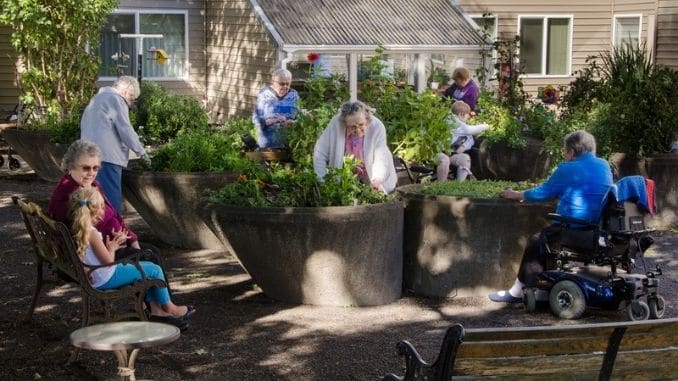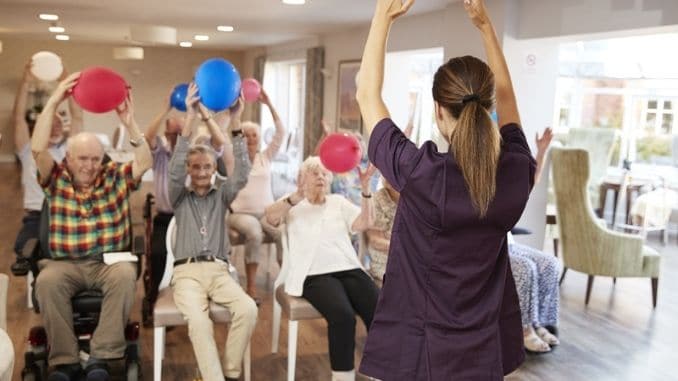According to the National Center for Assisted Living (NCAL), there are more than 835,000 Americans currently residing inside assisted living communities. The majority of these are women 85 or older.
Overall, about one million Americans are living in some type of senior living community and that number is expected to double by the year 2030, mainly because of an increase in the senior population.
Assisted living communities can help promote independence among residents while offering them the chance to stay socially active. They can also ease the burden on caregivers as residents have access to skilled nursing and rehabilitative care.
After the COVID-19 pandemic, however—which hit nursing homes and other senior living areas particularly hard—many families are understandably nervous about having a loved one move away from home. Fortunately, there are steps you can take to help ensure your loved one’s safety and security.
What is Assisted Living?
There are a lot of terms thrown around when it comes to senior living options. The difference between them typically refers to the level of care the residents can expect to receive.
“Assisted living” generally refers to communities that serve individuals who need some help with everyday activities and health care, but don’t require 24-hour ongoing skilled nursing care. Other terms for this same type of care include “residential care” or “person-centered care,” but the point is that the care and services are tailored to meet the residents’ individual needs.
The mission of an assisted living center is to maximize and retain the resident’s independence for as long as possible. Residents enjoy a home-like setting with a mix of companionship, independence, privacy, and security. The facility usually offers services like meals (in a restaurant-like setting), medication management, nursing care (as needed), recreational and spiritual activities, laundry service, housekeeping and maintenance, exercise and wellness programs, and transportation.
Most of these communities also offer other types of healthcare services, such as coordination of appointments with outside health care providers, regular monitoring, transportation to health appointments, and other types of assistance.
What’s the Difference Between Assisted Living and a Nursing Home?
Though both of these facilities offer medical care, security, and other services like meals, maintenance and housekeeping, laundry, and the rest, the differences primarily revolve around medical services and the physical setup of the residences.
While residents in an assisted living facility may require some care, such as help getting up from a chair or into a car, managing their medication, or general supervision because of memory issues, residents living in a nursing home usually require a much higher level of care—often around the clock monitoring.
Nursing home residents usually have more serious health conditions that require the ongoing assistance of a skilled nurse, physical therapist, or speech therapist. Some may require respiratory care services, maybe bedridden or wheelchair-bound, or require ongoing palliative and preventative long-term care.
The mission of a nursing home also differs from that of an assisted living facility. Whereas assisted living personnel strive to make sure residents maintain at least some level of independence, a nursing home focuses on ensuring the safety and comfort of older adults who can no longer live on their own.
More simply put, assisted living communities are for adults who are still mostly independent but require some help with day-to-day living, while nursing homes are for seniors who require 24-hours medical supervision because of serious physical or mental conditions that make it impossible for them to take care of themselves.
These two facilities are also different in their physical setup. Whereas a nursing home often looks more like a hospital or other type of medical institution, an assisted living community usually resembles an upscale apartment community. Nursing home residents often share a room with another senior, while assisted living residents typically have their own apartment or suite.
Why It’s Important to Understand What Assisted Living Really Is
It’s important for seniors to clearly understand the difference between these two types of facilities. Many seniors are understandably resistant to moving into or “being put into” a nursing home because of all the stories they’ve heard. Assisted living, however, is a fairly new option that rose in popularity during the 1990s.
It was Dr. Keren Brown Wilson who created the first assisted living care facility in Oregon in the late 1980s. She had seen her own mother go into a nursing home when she didn't need to—she still had some ability to take care of herself. Karen realized the gap that existed in senior care, so she started the first assisted living facility to provide seniors with a more independent option.
The idea took hold and soon became extremely popular. In the 1990s, assisted living spread throughout the country until it became widely available, as it is today. Residents appreciate that they provide more privacy while still offering assistance where needed. Many of these facilities also accept Medicaid, making them a more feasible option for many seniors.
When Is It Time to Consider Assisted Living?
It can be hard to determine when you or a loved one should consider moving into an assisted living community. There are some signs you can watch for that will help.
- Difficulty managing finances or other money problems
- A worsening of medical conditions to the point of risking safety (increased falls)
- Depression or social isolation
- Lack of participation in hobbies or other activities they used to enjoy
- Difficulty keeping the house clean or at least livable
- Difficulty in caring for oneself (bathing, oral care, nutrition)
- Trouble managing laundry (wearing dirty, smelly clothes)
- Mental decline that creates safety risks (confusion, memory loss)
- Aggressive behavior (signaling dementia or emotional stress)
- Difficulty managing medications (not taking them on time)
- Wandering or getting lost
If you are taking care of a senior who is exhibiting these signs, your own burnout may also signal the need for help. If you notice your health deteriorating, you're struggling to give your loved one all the care he or she needs, or you’re experiencing other issues that are related to caregiving, it’s probably time to make a change both for your loved one and yourself.
Finally, consider the fact that an assisted living facility may cost less than in-home care. Though many seniors would prefer to stay in their homes, hiring a caregiver can exceed the available financial resources. Assisted living facilities aren’t cheap either, but they may be more affordable than in-home care, particularly if the resident’s insurance can help.
Deciding to move into an assisted living community can be difficult, but it's important to consider whether you or your loved one may be safer, healthier, and even happier if in a place where care is available.
What to Look for in an Assisted Living Facility
Once you decide that it’s time to consider moving, you may wonder how to find the best assisted living community. Here are a few things to consider.
- Location
Most of the time, residents will want to remain as close to their family and friends as they can, so location matters. It can also help a resident to transition more easily if she remains in an area that looks familiar.
In some cases, though, your location may be a hindrance. Some states limit how much medical assistance an assisted living center can offer. If the resident needs more, you may have to look to another state near yours for the right level of care. On the other hand, if the resident is still pretty independent, those limitations may work out perfectly.
You can find state-related data on NCAL’s website.
- Size
Assisted living communities vary largely when it comes to size. Some have only about 10 rooms, where others can have hundreds. Your preference here is largely personal. If you’re used to a quiet life, you may prefer a smaller facility, and vice-versa.
Consider too that larger facilities are more likely to have extras like movie theaters, swimming pools, and specialized units for memory care.
- Staff-to-Resident Ratio
How many staff members are available to help? This tends to vary among facilities, so it’s something to consider. The less care you need, the less this will matter, but if you have a medical condition that will likely worsen as you age, you may want a facility that has the staff available to meet your needs. In general, the lower the staff-to-resident ratio, the better.
Also, ask about the staff's experience and training. The more medical care you require, the more important this question will be. Ask if the community conducts criminal background checks on their employees. This can help reduce the risk of elder abuse.
When you go to tour the facility, pay special attention to how the staff is interacting with the residents. You may even ask to stay overnight—some facilities allow prospective residents and their families to arrange a stay so they can figure out whether the community is right for them.
- Type of Care Offered
Medical care can vary among assisted living communities. Consider the type of care you or your loved one needs, then see if that care is offered at the center you’re considering. Ask about the services offered and about equipment that may be available. Take a look around and see if you feel comfortable with the level of care you witness.
Also, check to see if the facility offers free transportation to the doctor and if the staff can arrange for the delivery of prescriptions. Finally, find out what happens if the resident's condition deteriorates.
- Other Services
The typical assisted living facility offers dining services, housekeeping, laundry, medication management support, exercise and wellness programs, and the like. Many now offer Alzheimer’s or dementia programs too, and some have other specialized areas of service like heart, diabetes, and depression programs.
Beyond health care concerns, look for other services that may enhance your life. These may include pet therapy, piano lounges, computer areas, and community outings or field trips.
- Types of Living Spaces
You can discover what these are like with a simple tour. These can vary from very simple apartments to more suite-like spaces. These may include kitchenettes so you can do your own cooking, areas where you can keep a pet, private bathrooms, and more. The more home-like these appear, the easier it will be to transition into them.
Ask about the living spaces—if you change or decorate them as you wish or if you can bring your own furniture, and if you or the facility is responsible for repairs. You may also want to find out what happens if you get married or have a friend or family member who wants to move in with you.

- Visiting Rules
Many family members were understandably distraught when they were blocked from seeing their loved ones in nursing homes and other senior facilities during the COVID-19 pandemic. Though the limitations were understandable considering the risks, it's important to know that in normal circumstances, you can visit your loved one (or have visitors) at any time.
- Accreditation or Licensing Reports
Some states license assisted living facilities. If you live in one that does, ask to see the inspection reports, along with any licensing.
In addition, there are two organizations now that offer independent accreditation—ask to see if the facility you’re considering has done so, and ask to see those accreditations.
- Rights of Residents
Before you sign on the dotted line, it’s important to understand your rights. Ask questions like the following:
-
- Can residents participate in facility management and decision-making?
- Do I have input into activity and meal planning?
- Is there a resident council?
- How are complaints and disputes handled?
- What are the grounds for eviction?
- What rules cover the day-to-day operation? What happens if you break a rule?
- Cost
This can make or break your decision, so ask about it upfront. There may be an entrance fee, a monthly fee, or other fees that change when the resident’s required level of care changes. Find out what services are covered in the regular fees, and which you have to pay extra for. Are the utilities included in the monthly fee, for example, or is cable television included?
It’s also very important to ask if you can receive Medicare or Medicaid coverage in the facility or if you will be required to buy private insurance or participate in a special group insurance program. Find out too what services are covered under the insurance plans and which you will be responsible for yourself.
How to Adjust to a New Assisted Living Facility
Once you’ve examined the facility and decided where you want to move, it’s time to transition from your home to the new living space. This can be difficult to do for anyone. Here are some tips to help make it easier:
- Spend considerable time visiting the community first. Get to know the people there and become familiar with the area so that it doesn’t feel so foreign. Go several times to be sure you feel comfortable.
- Make your space your own. Depending on what the facility allows, make your living space as much yours as you can. Bring your decorations, pictures, books, and anything else that will help you feel more at home.
- Get involved. Do your best to join the available group activities. The faster you get to know the other residents, the more comfortable you will feel. Dine with other residents and ask the community social director to find out what activities are scheduled.
- Most assisted living communities have exercise and fitness opportunities available. Take advantage of these. Staying fit and active is good for your physical health and will also boost your mood and help you adjust.
- Maintain your community involvement. Just because you move into an assisted living facility doesn’t mean you can’t remain active in your larger community. You’ll still have the freedom to go to the grocery store, visit your friends, do your volunteering, or take part in any other activities that were part of your life before. If you need transportation, ask if the facility offers it, or if they can arrange other options for you.
- Give yourself time. Even if you do everything right in the transition, it’s common to feel anxious and unsettled for a while. Give yourself time to adjust and be patient with yourself (or with a loved one).

Remember, although the move to an assisted living environment will be different, change isn’t always a bad thing. Ask the right questions and find a community that feels like home. Engage with others and take part in the activities offered. Make the most of your Golden years.
Stay strong, stable and confident at any age. Learn how by clicking here.











